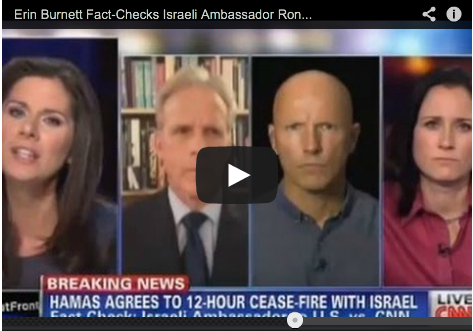AUGUST 7, 2014 – I have been a journalist for a quarter of a century. I have covered terrorism both in Israel and internationally. I reported on the war in the Balkans, on upheavals in Russia since the fall of the Communism, on peace negotiations between Israel, the Palestinians and the Syrians. I have covered the synagogue bombings in Istanbul and I covered the hotel bombing in Taba, Egypt in 2004
In the early days of what looks like a ceasefire that may hold in Israel, and in the days before war crime charges will most certainly be filed against Israel, I am more worried than ever that my profession has been compromised; some would even say that journalism is dead.
It was during the reporting on the Second Intifada in Israel that I began to notice an erosion of the basic tenets of journalism. Journalists became vehicles for the Palestinian narrative of injustice rather than simply impartial observers of a complex conflict.
In the current war, international media coverage makes it appear to viewers as if every morning Israelis wake up and ask ourselves – how many Palestinian children shall we kill today? Colonel Richard Kemp, the former Commander of British Forces in Afghanistan, put it this way:
“To suggest that military incompetence is the only explanation for civilian deaths other than deliberate mass murder reveals a breathtaking but unsurprising ignorance of the realities of combat. Although rarely allowed to complete so much as a single sentence, Israeli attempts to explain IDF targeting policies are inevitably dismissed as laughable fabrication.”
In my view, there has been no real reporting in this conflict. While everybody agrees that there are Palestinian civilian casualties – the ratio of 70 to 80 percent remained unchanged during the month long war — how is this possible? Where are the Hamas militant casualties?
Michael J. Totten writes compellingly of inflated and inaccurate numbers in The World Affairs Journal.
“Analyses of the casualties listed in the daily reports published by the Palestinian Center for Human Rights, a Gaza-based organization operating under Hamas rule, indicate that young males ages 17 to 30 make up a large portion of the fatalities, and a particularly noticeable spike occurs between males ages 21 to 27, a pattern consistent with the age distribution typically found among combatants and military conscripts.”
In the international media however, we have not seen photos of these men, many of whom are likely Hamas militants, just countless pictures of Palestinian children.
Media reporting on European views of the crisis in Gaza are complex and seen almost solely through media bias and exploitation of previously held ideas about underdogs, anti-Semitism and emotion versus reason.
If there is a crisis in journalism, the Arab-Israeli highlights the crisis as never before.
Former Israeli Ambassador to the US Michael Oren was interviewed on CNN after Ron Dermer, the current Israeli Ambassador to the US complained that CNN’s coverage was focused on pictures of Palestinian children, while not mentioning the UN school that housed rockets.
As CNN asked Oren about his views on media bias, his picture was minimized while the entire screen was filled with pictures of Palestinian children – from the same loop we had already seen. Even an after-the-fact interview to discuss media bias…contained media bias. The images shown have an obvious and not so subliminal affect on viewers. See the interview here, queued up to the section to which I refer.
According to the Committee for Accuracy in Middle East Reporting in America, in an L.A. Times slideshow of more than 75 photographs from the conflict, there’s not a single image of a Hamas fighter.
Again, according to Richard Kemp:
“…the Palestinian body count is vital to Hamas’s propaganda war that aims to bring international pressure on Israel and incite anti-Israeli and anti-Semitic hatred around the world.”
Either journalists are no longer observing as impartially as possible or they are censoring themselves — or even being censored. In any case, the end result is that journalists, wittingly or unwittingly are serving Hamas’s propagandist aims. This is not journalism.
The Washington Post published a list of forty questions that journalists covering this conflict should be asking themselves. Among the questions, two are key to whether journalists in Gaza are doing their jobs:
- Have you seen Hamas fighters in Gaza?
- If yes, why have you not directly reported Hamas fighting activity when you are eye-witnesses in Gaza, but rather indirectly reported about what the IDF says Hamas has done?
To complicate matters, information sharing on social media networks has created a perfect storm of media overload. In Israel, Gaza, War & Data, Gilad Liton says:
“Not only is there much more media produced, but it is coming at us at a faster pace, from many more sources. As we construct our online profiles based on what we already know, what we’re interested in, and what we’re recommended, social networks are perfectly designed to reinforce our existing beliefs.”
Operation Protective Edge has not only shaken the world and tragically taken many lives but I am afraid there is another casualty as well: integrity in journalism.
Written by IZZY LEMBERG
Originally published on Aug 7, 2014 on The Times of Israel. View the original article here.

